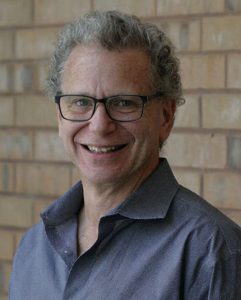Dr Josh Rubin – Understanding Sex Differences in Cancer Promises Better Treatment and Survival
Differences in the prevalence and survival of male and female cancer patients have long been acknowledged but not well understood. Dr Josh Rubin (Departments of Paediatrics and Neuroscience at Washington University) and his collaborators have been the first to identify sex-specific differences in malignant transformation. This evidence will help to optimise sex-specific approaches to cancer treatment and contribute to the improvement of the outcomes and survival of cancer patients.
Sex Differences in Brain Tumours
‘Cancer exhibits a significant sex difference in rates and survival. Males get more cancer and die more often from their cancer than females do’ explains Dr Josh Rubin from the Departments of Paediatrics and Neuroscience at Washington University School of Medicine, USA. Many of the disparities between male and female disease can be explained by differences in sex hormones. One example is the higher occurrence of autoimmune disease in females of reproductive age and the increased incidence of cardiovascular disease in postmenopausal females.
However, not all sex disparities can be explained by the activity of circulating sex hormones. For example, certain brain tumour types occurring in very young and peripubertal children are twice as likely to develop in boys than in girls. In cases such as these, circulating sex hormones can neither explain the vulnerability of males nor the protection of females. These observations led the research group headed by Dr Rubin to investigate the alternative mechanisms by which sex may be influencing brain tumourigenesis in humans.

Higher Prevalence of Glioblastoma in Males
In adults, glioblastoma (GBM) is the most common type of brain cancer. Multiple recent reports from collaborator, Dr Jill Barnholtz-Sloan, have established that GBM is much more prevalent in men and the 5-year survival rate is significantly lower in men compared with females with GBM. In a 2014 paper, Dr Rubin and colleagues reported their investigation into whether there is an effect of sex on cell-intrinsic sexual dimorphism in tumour progenitor cells.
At the time, GBMs were divided into four subtypes (classical, mesenchymal, neural and proneural), based on their gene expression profile. Looking at two data sets for GBM, the team found that all subtypes other than classical GBMs were more prevalent in males with the greatest difference – two-fold – for the mesenchymal subtype. This suggested to the team that the effect of sex on GBM was dependant on the molecular subtype of the disease. Dr Rubin and his group went on to demonstrate, for the first time, that there are sex-specific, cell-intrinsic differences in malignant transformation.
To accomplish this, Dr Rubin and Dr Tao Sun focused on sex differences in the cellular response to loss of two tumour suppressor genes commonly mutated in GBM, Neurofibromin (NF1) and p53. The loss of both NF1 and p53 in astrocytes, the cell lineage from which glioblastoma rises, led to malignant transformation of male, but not female, astrocytes, suggesting that sex is a factor in glioma formation upon loss of NF1 and p53 function.
The first step was to isolate male and female astrocytes with complete loss of Nf1 (Nf1-/-) and to assess whether they differed in their growth rates. While the loss of Nf1 alone was not associated with any sex difference in growth rates, the additional loss of p53 function resulted in a greater increase in the growth of male astrocytes as compared with female astrocytes. Upon further activation of the epidermal growth factor receptor (EGFR) – a protein involved in cell growth and differentiation (and frequently activated in GBM) male cells, but not female cells were fully transformed.
In order to assess whether this would result in sex differences in in vivo tumourigenesis, Dr Rubin and colleagues implanted the male and female cells into the brains of male and female immunocompromised mice. They found that 100% of recipient mice implanted with the male astrocytes developed tumours and died of the disease. In contrast, only 36% of recipient mice implanted with the female astrocytes developed the disease and died. A closer look at the tumours revealed that tumourigenesis was determined by the sex of the implanted cells and not by the sex of the recipient mouse.
To better understand this result, the team examined the regulation of the retinoblastoma protein (RB) pathway which is a negative regulator of proliferation. RB loss or inactivation is one of the most common features of human cancers. Experiments revealed that male astrocytes exhibited much greater time dependant phosphorylation of RB (which inactivates the inhibitory functions of RB) compared with female astrocytes, strongly indicating that RB regulation is sexually dimorphic in these astrocytes and leads to greater proliferation in male cells. When p53 and RB pathways were inactivated in male and female Nf1-/-astrocytes, male and female astrocytes are equally transformed. Dr Rubin and colleagues concluded that sexual dimorphism in the regulation of RB function is likely to be contributing to sex differences in cancer.
‘The importance of what we have found is how it will inform efforts to develop sex-specific approaches to cancer therapy.’
Sexual Dimorphism and Decreased Survival in Males
Next, Dr Rubin and Dr Joseph Ippolito wanted to investigate the role of metabolism in the sex disparity seen in brain cancers. Metabolism is a key factor in tumour survival and tumourigenicity, and one of the hallmarks of cancer metabolism is enhanced glucose uptake and its conversion to lactate, even in the presence of oxygen. This process results in the rapid generation of adenosine triphosphate through glycolysis, and also contributes to the pathways required for proliferation.
The data revealed that the overexpression of glycolytic genes resulted in decreased survival in males. Moreover, patients within this high-glycolytic group showed significant differences in the presence of key genomic alterations, including isocitrate dehydrogenase (IDH) mutation compared with the low-glycolytic group. Overall, the study showed that glycolytic stratification defined poor prognosis in males. The research unexpectedly revealed that females with high-glycolytic gene expression and wild type IDH mutation survived longer than all other wild type patients. The findings from these studies suggest a synergistic relationship between sex, tumour metabolism and genomic alterations in glioma.

Cell Cycle Inhibitors p16 and p21
Dr Rubin and his team, having previously found that sex differences in the regulation of RB correlated with differences in clonogenic cell function, cell proliferation and in vivo tumourigenesis, then wanted to investigate how cyclin dependant kinase (CDK) inhibitors contribute to sex differences in RB regulation, tumourigenesis and response to DNA damage. CDK inhibitors function as cell cycle inhibitors and the team looked at p16, p21 and p27 in mice GBM astrocytes under conditions that promote RB-dependant growth arrest.
They first examined the expression of the CDK inhibitors. Female cells had higher levels of p21 protein expression compared to male GBM astrocytes and female tumours expressed significantly higher levels of p21. These data confirmed to the team that there are significant sex differences in the expression of these key negative regulators of cell growth.
To investigate whether these differences in p21 expression might underlie female protection from transformation, Dr Rubin and Dr Najla Kfoury looked at whether there were differences in the expression of these regulators in response to changes in growth factor availability and DNA damage, two stressors that activate CDK inhibitors under normal circumstances. Serum (growth factor) was withdrawn for 48 hours from GBM astrocytes and the researchers found that p16 mRNA and protein levels were significantly higher in female but not in the male astrocytes. When DNA damage was initiated by etoposide there was a substantial increase in p21 mRNA and protein in both female and male GBM astrocytes, but the increase was far greater and more significant in female astrocytes. They went on to demonstrate that when they deleted p16 and p21 from female GBM astrocytes, they responded like male astrocytes to these conditions, indicating that expression of CDK inhibitors was required for the relative female protection from transformation.

Sex Differences in GBM Treatment Response and Survival
More recently, Dr Rubin and Dr Kristin Swanson used a method based on magnetic resonance imaging to calculate tumour growth velocity in patients as a measure of response to treatment. The study found that females had a better response to standard treatment than males with GBM. The data suggest that females with GBM may benefit more from standard treatment than males with GBM and the difference in response may be due to tumour growth velocity which in turn may contribute to survival. Next, Dr Rubin and Dr Will Yang looked at potential differences in GBM by examining transcriptome (collection of all RNA transcript) data from The Cancer Genome Atlas for GBM. These experiments identified sex-specific molecular subtypes of GBM and revealed that expression of cell cycle regulators correlates with survival in male GBM and integrin signalling correlates with survival in females, further supporting the importance of sex differences in GBM.
Implications for the Future of GBM Diagnosis and Treatment
The research by Dr Rubin and colleagues highlights the significance of understanding the molecular basis for sexual disparity in GBM. This understanding will lead to the development of diagnostics and treatments that take sexual disparity into consideration. Dr Rubin explains ‘The importance of what we have found is how it will inform efforts to develop sex-specific approaches to cancer therapy’. Targeting sex-specific components of the disease undoubtedly holds the potential to improve outcomes for both male and female cancer patients.
Reference
https://doi.org/10.33548/SCIENTIA563
Meet the researcher

Dr Joshua B. Rubin
Washington University in St. Louis
School of Medicine
Neuroscience
St. Louis, MO
USA
Dr Joshua B. Rubin is currently a Professor of Paediatrics and Neuroscience at Washington University of Medicine in St. Louis, USA. Dr Rubin obtained his MD and PhD from the Albert Einstein College of Medicine in New York City in 1994. Following his doctoral research, Dr Rubin completed a residency in Paediatrics at Boston Children’s Hospital followed by a fellowship in Paediatric Haematology and Oncology at the Dana Farber Cancer Institute and Harvard Medical School to train, where he concentrated on paediatric neuro-oncology. Dr Rubin’s research team focuses on the mechanisms of tumourigenesis and resistance to therapy with the aim of improving the outcomes of patients with malignant brain tumours. Amongst numerous positions on advisory boards and panels, Dr Rubin has been an author on over 100 publications. As an esteemed international basic and clinical researcher, Dr Rubin has been awarded substantial and prestigious funding to support his work.
CONTACT
E: rubin_j@wustl.edu
KEY COLLABORATORS
Rosy Luo (Washington University School of Medicine)
Robi Mitra (Washington University School of Medicine)
Will Yang (Washington University School of Medicine)
Joseph Ippolito (Washington University School of Medicine)
Sonika Dahiya (Washington University School of Medicine)
Kristin Swanson (Mayo Clinic, Scottsdale)
Jill Barnholtz-Sloan (Case Western Reserve University)
Justin Lathia (Cleveland Clinic)
Michael Berens (TGen)
James Connor (Pennsylvania State University)
CURRENT FUNDING
National Institutes of Health
Children’s Discovery Institute
Prayers from Maria Foundation
Barnes Jewish Foundation
American Brain Tumor Foundation
FURTHER READING
JB Rubin, JS Lagas, L Broestl, J Spomagel, N Rockwell, G Rhee, SF Rosen, S Chen, RS Klein, P Imoukhuede, J Luo, Sex differences in cancer mechanisms, Biology of Sex Differences, 2020, 11, 17.
M Dong, G Ciofi, J Wang, KA Waite, QT Ostrom, C Kruchko, JD Lathia, JB Rubin, ME Berens, J Connor, JS Barnholtz-Sloan, Sex differences in cancer incidence and survival: A pan-cancer analysis, Cancer Epidemiology, Biomarkers and Prevention, 2020, 29, 1389.
W Yang, NM Warrington, SJ Taylor, P Whitmore, E Carrasco, KW Singleton, N Wu, JD Lathia, ME Berens, AH Kim, JS Barnholtz-Sloan, KR Swanson, J Luo, JB Rubin, Sex differences in GBM revealed by analysis of patient imaging, transcriptome, and survival data, Science Translational Medicine, 2019, 473, eaao5253.
N Kfoury, T Sun, K Yu, N Rockwell, KL Tinkum, Z Qi, NM Warrington, P McDonald, A Roy, SJ Weir, CA Mohila, B Deneen, JB Rubin, Cooperative p16 and p21 action protects female astrocytes from transformation, Acta Neuropathologica Communications, 2018, 6, 12.
JE Ippolito, AK Yim, J Luo, P Chinnaiyan, JB Rubin, Sexual dimorphism in glioma glycolysis underlies sex differences in survival, JCI Insight, 2017, 2, e92142.
T Sun, NM Warrington, J Luo, MD Brooks, S Dahiya, SC Snyder, R Sengupta, JB Rubin, Sexually dimorphic RB inactivation underlies mesenchymal glioblastoma prevalence in males, The Journal of Clinical Investigation, 2014, 124, 4123–33.

Want to republish our articles?
We encourage all formats of sharing and republishing of our articles. Whether you want to host on your website, publication or blog, we welcome this. Find out more
Creative Commons Licence
(CC BY 4.0)
This work is licensed under a Creative Commons Attribution 4.0 International License. 
What does this mean?
Share: You can copy and redistribute the material in any medium or format
Adapt: You can change, and build upon the material for any purpose, even commercially.
Credit: You must give appropriate credit, provide a link to the license, and indicate if changes were made.
More articles you may like
Grandmothers: Innovation Through Tradition
Grandmother Project – Change through Culture (GMP) is an organisation dedicated to documenting the role of grandmothers and demonstrating the effectiveness of grandmother-inclusive strategies in improving the health and well-being of women, children, and adolescents. GMP’s groundbreaking work challenges conventional wisdom to transform community-based interventions in Africa and beyond, harnessing a powerful but often overlooked resource: the wisdom and influence of grandmothers.
Dr Robert Larkin | Cultivating Change to Improve Soil Health and Increase Potato Yield
Environmental quality and food production are facing the pressing challenges of climate change and global population growth. Dr Robert Larkin from the United States Department of Agriculture-Agricultural Research Service (USDA-ARS) and a team of plant scientists developed and tested a range of crop management systems to help overcome these compounding challenges. Their work is improving soil health and increasing the yield of potato crops, contributing to the future food security of nations.
Professor Giorgio Buttazzo | Artificial Intelligence and a Crossroads for Humanity
Where do we stand with artificial intelligence? Might machines take over our jobs? Can machines become conscious? Might we be harmed by robots? What is the future of humanity? Professor Giorgio Buttazzo of Scuola Superiore Sant’Anna is an expert in artificial intelligence and neural networks. In a recent publication, he provides considered insights into some of the most pressing questions surrounding artificial intelligence and humanity.
Dr Ralf Adam | New Technologies Shaping the Future of Oral Hygiene
Understanding the efficiency of various toothbrush technologies is essential for achieving optimal oral health. Dr Ralf Adam, who leads a dedicated team at Procter & Gamble in Germany, is keen to investigate the complexities of these technologies. His team have provided new insights into the best toothbrush types for plaque removal and the maintenance of gum health. By highlighting the importance of informed oral care decisions and ongoing investigations, this vital research works towards ensuring everyone can achieve a brighter, healthier smile.




